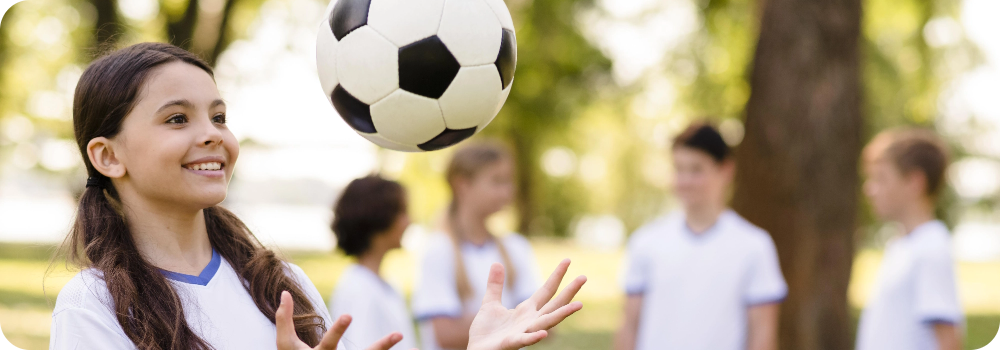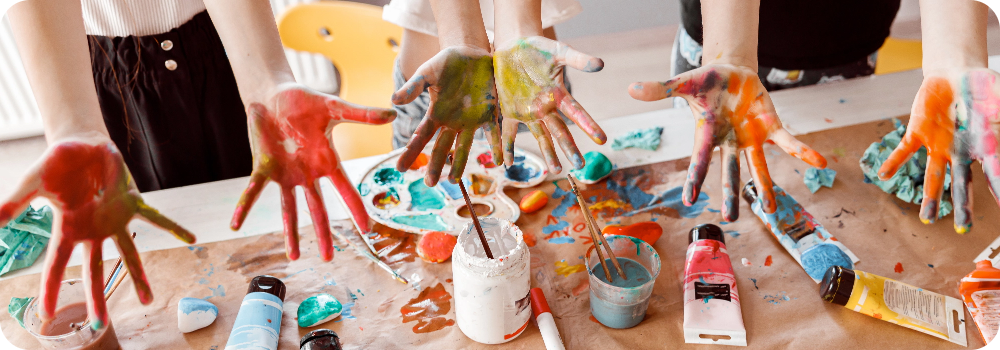Daily Routine
The daily routine of a child in our schools is full of activities. They have so many things that they have to do, that many times, we have to push them out of the school at the end of the day!
The daily routine has been designed to have a fine balance between academics, play and nutrition. We make sure that there is no overdose of academics, and that children get nutrition at regular intervals. We also make sure that one meal is served after sports, as that is when the children need it the most. As explained in the academic facilities section, we have subject-wise classrooms, which give children a break for 2 minutes between each period.
Of course, we have co-curricular activities like drawing, craft and music, which let children relax a little, and also express themselves wonderfully. The star attraction for students, however, is our activity periods! Every time they go for an activity period, they expect a surprise! You will find more details of that in the activities section.
As we have mentioned, technology and computers are at the core of our methodology. Children regularly get exposed to our learning system, which we use for testing and remedial teaching.
Apart from these things, we regularly have events – and many of them. We have the annual gathering (every child participates), the science exhibition, a Diwali carnival, a Fun Fair, student conferences and a host of talks from professionals, ranging from road safety to career guidance. The idea is to expose the children to a variety of things, which will open up their perspective and make them smarter individuals.
How could we forget our dear parents? We have alternate open Saturdays for parents to come and interact with the teachers, and find out about how their child is doing in school. Extra training for scholarship and sports happen on these days too.
As all our parents know, whatever we do involves some thought behind it. This applies to our uniform too. We have a smart track pant and a T-shirt for all our students – boys and girls! This puts them at complete ease when playing sports, and sitting in class too.
All of this applies to Kindergarten students too (well, almost of all of it), though everything shrinks in scale for them!
Academics

Planning plays a major role in imparting academics to the children in a re:Think School. The idea is to present a concept to the students or allow them to build one on their own based on certain planned observations and activities. Then they have discussions and debates to reinforce what they have figured out. They are also given printed and plain writing handouts which have more questions and problems to solve. There are sheets for revision, learning and exercises and activities too. Values, analysis, application, knowledge, information – all these things are taken care of in one go.
Students have their own set of textbooks for themselves at home. The textbooks that are needed in school are kept in school itself. So no textbooks need to be carried between home and school.
Students have access to e-learning, and a set of textbooks at home. They also have certain creative or interesting assignments such as actually performing a certain experiment; others may involve reading a book, interviewing a person, reading an article or even actually commenting on a situation. All this is planned in advance for each and every class – even before the academic year begins. The teachers are informed of the schedules, educational kits are packed, worksheets are printed and everything is kept ready for the children.
System of sheets

The children take home the sheets that they write and solve in school every day. They even take home the printed sheets that are given to them in class. At the beginning of the year children are given files for each subject. They are expected to file these sheets when they go home every day. They “build” notebooks for every subject. At the end of the year, these children have written and studied a lot more material than a student of any traditional school. In a way, being bag-less gives us a much better academic quality than any other school.
Sports

We know that a sound mind can reside only in a sound body – so physical fitness is the primary necessity of an individual’s well-being. It follows, of course that some regular sports activity is necessary. But, in our schools the thought goes way beyond that!
The playground is where a child understands the dynamics of teamwork, leadership and strategy. Children get the concept of winning, losing and sportsmanship simply when they get out there and play. They have to understand each other’s cues, body language and emotions. They need to communicate, analyse their weaknesses, sharpen their skills and keep improving with practice. Playing sports builds character and develops personality. All these things are so immensely important for an individual that we just cannot imagine not having sports and missing out on all these qualities.
Playing has its own obvious advantages too. The children learn many different games in their school years. Even later, after the child leaves school, he or she can continue pursuing some game as a hobby which acts as a good stress buster for their adult life. Children attain reasonable proficiency in multiple sports to enable them to enjoy the game. Those who show special aptitude are trained to attain district, state and national level honours too.
Arts

Educating the children involves teaching them how to express their ideas, feelings and experiences. There is no better way to do it than through arts education. This is a really great way to work on multiple intelligence development. Arts education makes children more aware of their senses and emotions. They can channel their emotional development, intelligence and creativity in wonderful ways as their sense of art develops over years of exposure. That is why art is taken so seriously in our schools.
Students are taught fine arts such as drawing, craft and sculpture. That helps children develop perception and skills of both real and imaginary things. Aesthetic sense develops as well and that stimulates the imagination of each individual. The use of diverse media in the fine arts encourages students to demonstrate self-expression, creative growth, discovery, the realization of ideas and exposure to global cultures.
Students are also taught performing arts such as dance, drama and music. Music encourages focused listening, concentration and attention. Children understand how to use sound – with the voice and with musical instruments. They have activities to develop their listening, performing and composing skills. In drama, they explore feelings, knowledge and ideas. They have to use themes and issues, present them and think about the insights they gain. They have to decide and take responsibility for the decisions in the safety of the drama environment. Dance allows the children to experiment with body movements to communicate a range of emotions as they understand different dance forms.
Our extensive experience in the working environment shows that the really successful people in life have always done “something extra” in their formative years – be it drama, sculpture, art or music. And that is exactly what we want – our students becoming really successful professionals or entrepreneurs!
Nutritious meals

Since we offer a ‘complete’ package, we have made arrangements to provide lunch and snacks to the students as well. Our associate organizations provide tasty and healthy meals to our students. If a child brings a tiffin from home, it usually consists of just rotis with some dry vegetable preparation. In the growing age, a child should receive a balanced meal with all the nutrients. So, from 1st standard onwards, children are served a ‘square’ lunch in the school. It consists of rotis, vegetables, salads, pickle, rice, dal and some curd preparation.
Children develop healthy eating habits for life and the inclination towards junk automatically reduces. All children also have a snack in the school. Children of the secondary section have a glass of milk in the school as well. The number of meals that a students has in school varies from class to class. Kindergarten children are given a snack. Children of 1st to 4th are given a snack and lunch. Children of standards 5th to 10th have two snacks and lunch in school. They are also given a glass of milk everyday. We also get a chance to teach them table manners. Even Nursery children pick up their plates and put them in the respective bins once they are done eating. They learn to chew properly and finish everything on their plate.
Children eventually even begin to teach their family members how to eat in a proper way! Mothers and grandmothers are happy as they do not face a question about what tiffin to pack for the child everyday! Having food in the school gives children a break from all activities. They sit with their group of friends in the cafeteria and relax and unwind.
Here is the lunch and snack menu. We shuffle it from time to time. The menu can also change at the last moment for a variety of reasons. This is on purpose because kids make a fuss on the day when there is an item on the menu which they don’t like, and plan accordingly!
Activities

The re:Think Learning System exposes students to a number of hands-on activities that make use of real-life skills. A healthy mix of academics and extracurricular activities leads to multi-dimensional learning; a must-have skill in today’s fast-paced world.
Right from the first standard, children are exposed to facilities like the Science lab, Language lab, Math lab. Children learn about current affairs, financial planning, analytical thinking and so on, through a unique treatment given to daily classroom sessions.
Students are given regular projects to do at home and school. We even keep the labs available for interested groups to come to the school on Saturdays for developing group projects.